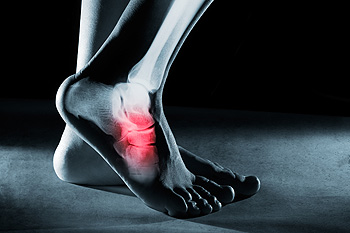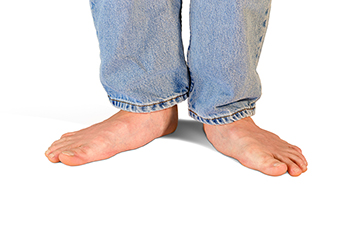January 2023
Who Knew Yoga Can Cause Foot Pain?

Yoga is relaxing and provides an excellent way to stay flexible and balanced throughout one’s life. There are several styles of yoga, such as Ashtanga, Iyengar, and Kundalini. Some of these styles of yoga involve transitional movements, like vigorous linked poses called the Sun Salutation, that require stepping or jumping back and landing on the pads of one’s toes. This action can lead to foot pain. Also, wearing shoes during yoga can constrict the feet, causing foot pain because the arches can’t carry the weight of the body. To eliminate foot pain while practicing yoga, it is suggested one changes their style of yoga and do it with yoga shoes or go barefoot on a clean mat. Yoga devotees can also practice some exercises that will bring back elasticity in the plantar fascia muscles that form the arch bed. Once such exercise is standing with the feet hip-width apart while keeping the head and chest tall and the lower abs drawn in towards the spine. Lift both heels as you contract the leg muscles. Pause before lowering the heels to the floor. This exercise should be done 10 to 20 times each day. If you would like more information about how to practice yoga in a way that is least apt to cause foot pain, consult with a podiatrist who is an expert in everything related to the feet and ankles.
Sports related foot and ankle injuries require proper treatment before players can go back to their regular routines. For more information, contact Corinne R. Kauderer, DPM of Dyker Heights Foot & Ankle. Our doctor can provide the care you need to keep you pain-free and on your feet.
Sports Related Foot and Ankle Injuries
Foot and ankle injuries are a common occurrence when it comes to athletes of any sport. While many athletes dismiss the initial aches and pains, the truth is that ignoring potential foot and ankle injuries can lead to serious problems. As athletes continue to place pressure and strain the area further, a mild injury can turn into something as serious as a rupture and may lead to a permanent disability. There are many factors that contribute to sports related foot and ankle injuries, which include failure to warm up properly, not providing support or wearing bad footwear. Common injuries and conditions athletes face, including:
- Plantar Fasciitis
- Plantar Fasciosis
- Achilles Tendinitis
- Achilles Tendon Rupture
- Ankle Sprains
Sports related injuries are commonly treated using the RICE method. This includes rest, applying ice to the injured area, compression and elevating the ankle. More serious sprains and injuries may require surgery, which could include arthroscopic and reconstructive surgery. Rehabilitation and therapy may also be required in order to get any recovering athlete to become fully functional again. Any unusual aches and pains an athlete sustains must be evaluated by a licensed, reputable medical professional.
If you have any questions please feel free to contact one of our offices located in Brooklyn, NY and Old Bridge, NJ . We offer the newest diagnostic and treatment technologies for all your foot and ankle needs.
A Common Reason for Stress Fractures

A hairline fracture that happens in the foot is known as a stress fracture. It can occur in one or more of the 26 bones in each foot and causes difficulty walking. A stress fracture happens gradually, and a common reason is from increasing speed and distance too quickly while running. After a proper diagnosis has been performed, which is generally done by having an MRI taken, treatment can begin. The foot has a better chance of making a complete recovery by keeping weight off of it, and crutches can be useful in accomplishing this. Many patients find it helpful to wrap the affected foot with an elastic bandage, which can help provide the necessary stability as the healing process occurs. If you have foot pain and think you may have a stress fracture, it is strongly urged that you are under the care of a podiatrist who can provide you with the correct medical treatment.
Stress fractures occur when there is a tiny crack within a bone. To learn more, contact Corinne R. Kauderer, DPM from Dyker Heights Foot & Ankle. Our doctor can provide the care you need to keep you pain free and on your feet.
How Are They Caused?
Stress fractures are the result of repetitive force being placed on the bone. Since the lower leg and feet often carry most of the body’s weight, stress fractures are likely to occur in these areas. If you rush into a new exercise, you are more likely to develop a stress fracture since you are starting too much, too soon. Pain resulting from stress fractures may go unnoticed at first, however it may start to worsen over time.
Risk Factors
- Gender – They are more commonly found in women compared to men.
- Foot Problems – People with unusual arches in their feet are more likely to develop stress fractures.
- Certain Sports – Dancers, gymnasts, tennis players, runners, and basketball players are more likely to develop stress fractures.
- Lack of Nutrients – A lack of vitamin D and calcium may weaken the bones and make you more prone to stress fractures
- Weak Bones – Osteoporosis can weaken the bones therefore resulting in stress fractures
Stress fractures do not always heal properly, so it is important that you seek help from a podiatrist if you suspect you may have one. Ignoring your stress fracture may cause it to worsen, and you may develop chronic pain as well as additional fractures.
If you have any questions, please feel free to contact one of our offices located in Brooklyn, NY and Old Bridge, NJ . We offer the newest diagnostic and treatment technologies for all your foot care needs.
Surgery for Big Toe Arthritis

Arthritis often strikes the joint connecting the big toe to the ball of the foot and can cause significant pain. This affliction is more common as one ages and cartilage wears away between the bones. A surgery can be performed where the bones are fused together with metal plates, but this can limit the flexibility of the toe. Another option is a type of implant that can be inserted between the bones and can cushion the aching joint. Such an implant can be as small as a miniature marshmallow. It is made of saline solution and polyvinyl alcohol, like that used in soft contact lenses. This material compresses a bit under pressure, much like real cartilage. If you suffer from arthritis in the big toe, consult with a podiatrist to see if surgery is a treatment that is right for you.
Foot surgery is sometimes necessary to treat a foot ailment. To learn more, contact Corinne R. Kauderer, DPM of Dyker Heights Foot & Ankle. Our doctor will assist you with all of your foot and ankle needs.
When Is Surgery Necessary?
Foot and ankle surgery is generally reserved for cases in which less invasive, conservative procedures have failed to alleviate the problem. Some of the cases in which surgery may be necessary include:
- Removing foot deformities like bunions and bone spurs
- Severe arthritis that has caused bone issues
- Cosmetic reconstruction
What Types of Surgery Are There?
The type of surgery you receive will depend on the nature of the problem you have. Some of the possible surgeries include:
- Bunionectomy for painful bunions
- Surgical fusion for realignment of bones
- Neuropathy decompression surgery to treat nerve damage
Benefits of Surgery
Although surgery is usually a last resort, it can provide more complete pain relief compared to non-surgical methods and may allow you to finally resume full activity.
Surgical techniques have also become increasingly sophisticated. Techniques like endoscopic surgery allow for smaller incisions and faster recovery times.
If you have any questions please feel free to contact one of our offices located in Brooklyn, NY and Old Bridge, NJ . We offer the newest diagnostic and treatment technologies for all your foot and ankle needs.
Effective Management Care for Diabetic Patients

Most people who have diabetes are aware of the importance of taking proper care of their feet. This often begins with checking the bottom of the feet for existing cuts and scrapes and can be done by using a mirror. A caregiver or family member may be able to help with this task if the patient is unable to perform this. Many diabetic patients develop neuropathy, which is the inability to feel sensations on the feet. This can happen from nerve damage, which may occur from having elevated blood glucose levels. An additional complication of diabetes is poor circulation, which may increase the risk of developing a foot ulcer. Effective management advice for diabetic patients consists of refraining from walking barefoot, trimming the toenails correctly, and implementing a gentle exercise and stretching regime. If you have diabetes, it is strongly urged that you are under the care of a podiatrist who can monitor and help you to manage this condition.
Diabetic foot care is important in preventing foot ailments such as ulcers. If you are suffering from diabetes or have any other concerns about your feet, contact Corinne R. Kauderer, DPM from Dyker Heights Foot & Ankle. Our doctor can provide the care you need to keep you pain-free and on your feet.
Diabetic Foot Care
Diabetes affects millions of people every year. The condition can damage blood vessels in many parts of the body, especially the feet. Because of this, taking care of your feet is essential if you have diabetes, and having a podiatrist help monitor your foot health is highly recommended.
The Importance of Caring for Your Feet
- Routinely inspect your feet for bruises or sores.
- Wear socks that fit your feet comfortably.
- Wear comfortable shoes that provide adequate support.
Patients with diabetes should have their doctor monitor their blood levels, as blood sugar levels play such a huge role in diabetic care. Monitoring these levels on a regular basis is highly advised.
It is always best to inform your healthcare professional of any concerns you may have regarding your feet, especially for diabetic patients. Early treatment and routine foot examinations are keys to maintaining proper health, especially because severe complications can arise if proper treatment is not applied.
If you have any questions please feel free to contact one of our offices located in Brooklyn, NY and Old Bridge, NJ . We offer the newest diagnostic and treatment technologies for all your foot and ankle needs.
Heel Pain Can Be Treated!
Effects of Overpronation

Pronation is simply how your foot hits the ground when you walk or run. When someone overpronates, it means that the foot rolls inward when taking a step. The outer edge of the heel generally hits the ground first, and then the foot rolls in toward the arch. This motion may put extra pressure on the muscles, tendons and ligaments. Overpronation can lead to a number of injuries, including ankle sprains, Achilles tendonitis, and plantar fasciitis. One way to determine whether or not you overpronate is to check out the bottom of your shoes. If the shoe is worn on the inside of the sole nearest the big toe, it may indicate overpronation. Next, stand in bare feet and look into a mirror to see if your feet are flat or have low arches. This is another indicator of overpronation. Symptoms of overpronation include heel or arch pain, flat feet, hammertoes, or pain in the knees, hips, or back. To be certain, it is a good idea to visit a podiatrist who can conduct a more formal examination and determine if orthotics can help to correct the condition.
If you have any concerns about your feet, contact Corinne R. Kauderer, DPM from Dyker Heights Foot & Ankle. Our doctor can provide the care you need to keep you pain-free and on your feet.
Biomechanics in Podiatry
Podiatric biomechanics is a particular sector of specialty podiatry with licensed practitioners who are trained to diagnose and treat conditions affecting the foot, ankle and lower leg. Biomechanics deals with the forces that act against the body, causing an interference with the biological structures. It focuses on the movement of the ankle, the foot and the forces that interact with them.
A History of Biomechanics
- Biomechanics dates back to the BC era in Egypt where evidence of professional foot care has been recorded.
- In 1974, biomechanics gained a higher profile from the studies of Merton Root, who claimed that by changing or controlling the forces between the ankle and the foot, corrections or conditions could be implemented to gain strength and coordination in the area.
Modern technological improvements are based on past theories and therapeutic processes that provide a better understanding of podiatric concepts for biomechanics. Computers can provide accurate information about the forces and patterns of the feet and lower legs.
Understanding biomechanics of the feet can help improve and eliminate pain, stopping further stress to the foot.
If you have any questions please feel free to contact one of our offices located in Brooklyn, NY and Old Bridge, NJ . We offer the newest diagnostic and treatment technologies for all your foot and ankle needs.





